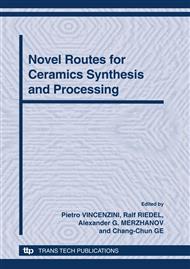[1]
G. Ferrari, G., The `Hows' and `Whys' of Armour Penetration, " MILTECH, 81-96 (1988).
Google Scholar
[2]
F. Thevenot, Boron carbide-a comprehensive review, Journal of the European Ceramic Society 6 (1990) 205–225.
Google Scholar
[3]
H. Lee, R.F. Speyer, Pressureless sintering of boron carbide, Journal of the American Ceramic Society 86 (2003) 1468–1473.
DOI: 10.1111/j.1151-2916.2003.tb03498.x
Google Scholar
[4]
R.S. Dobedoe, G.D. West M.H. Lewis, Spark Plasma Sintering of Ceramics, (2003).
Google Scholar
[5]
J.E. Zorzia, C.A. Perottoni, J.A.H. da Jornada, Hardness and wear resistance of B4C ceramics prepared with several additives, Materials Letters 59 (2005) 2932 – 2935.
DOI: 10.1016/j.matlet.2005.04.047
Google Scholar
[6]
M.V. Swain, Structure and properties of ceramics, in: R.W. Cahn, P. Haasen, E.J. Kramer (Eds. ), Materials Science and Technology, vol. 11, VCH Publishers Inc., NY, USA, 1993, p.175–258.
Google Scholar
[7]
L. Levin, N. Frage, M.P. Dariel, A novel approach for the preparation of B4C-based cermets , International Journal of Refractory Metals & Hard Materials 18 (2000) 131-135.
DOI: 10.1016/s0263-4368(00)00012-3
Google Scholar
[8]
Hae-Won Kim, Young-Hag Koh, Hyoun-Ee Kim, Densification and Mechanical Properties of B4C with Al2O3 as a Sintering Aid, J. Am. Ceram. Soc., 83.
Google Scholar
[11]
(2000) 2863–65.
Google Scholar
[9]
A. Goldstein, Y. Yeshurun, A. Goldenberg, B4C/metal boride composites derived from B4C/metal oxide mixtures, Journal of the European Ceramic Society 27 (2007) 695–700.
DOI: 10.1016/j.jeurceramsoc.2006.04.042
Google Scholar
[10]
C. Subramanian, T.K. Roy, T.S.R. Ch. Murthy, P. Sengupta, G.B. Kale, M.V. Krishnaiah, A.K. Suri, Effect of Zirconia Addition on Pressureless Sintering of Boron Carbide,; Ceramics International 34 (2008) 1543–1549.
DOI: 10.1016/j.ceramint.2007.04.017
Google Scholar
[11]
Adrian Goldstein, * Ygal Geffen, and Ayala Goldenberg, Boron Carbide–Zirconium Boride In Situ Composites by the Reactive Pressureless Sintering of Boron Carbide– Zirconia Mixtures J. Am. Ceram. Soc., 84.
DOI: 10.1111/j.1151-2916.2001.tb00714.x
Google Scholar
[3]
(2001) 642–44.
Google Scholar
[12]
S. Hayun, S. Kalabukhov, V. Ezersky, M.P. Dariel, N. Frage, Microstructural Characterization of Spark Plasma Sintered Boron Carbide Ceramics, Ceramic International, 36 (2010) 451-457.
DOI: 10.1016/j.ceramint.2009.09.004
Google Scholar
[13]
N. Frage, S. Hayun, S. Kalabukhov, and M. P. Dariel, The Effect of Fe Addition on the Densification of B4C Powder by Spark Plasma Sintering, Powder Metallurgy and Metal Ceramics, 46 (2007) 711-12.
DOI: 10.1007/s11106-007-0082-9
Google Scholar


